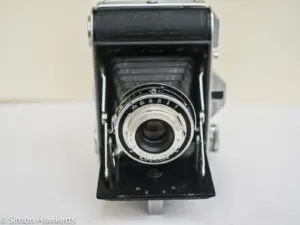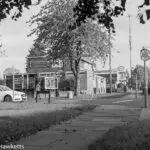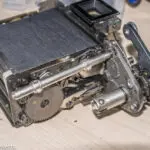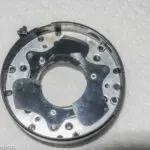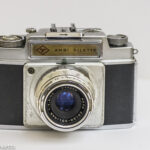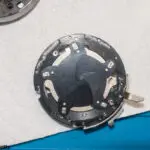I recently loaded a roll of FP4+ black & white film in my Selfix 1620 and took it for a spin around the town. Because it's been a very long time since I took photographs with a camera of this type, I thought I'd record my impressions and observations when shooting with a folding camera.
The first thing I realised quite early on is that you have to do everything manually in order to capture the picture. OK - that's obvious I suppose, but although I knew that it really didn't sink in until I took my first picture. I used a light meter app on my phone to measure the exposure and carefully set the speed and aperture I was going to use. Because the speeds are quite limited and slow I decided on the fastest speed available which was 1/300sec and that meant I needed an aperture of f/8. With these set I turned the camera to landscape mode and tried to compose the picture using the small viewfinder. I carefully squeezed the shutter button and nothing happened. Of course - I hadn't cocked the shutter! So I cocked the shutter and re-composed and tried again. This time there was a slight click from the front of the camera and I knew I'd exposed my first 120 frame in about 45 years.
I folded the lens carefully back into the camera body and walked on when it suddenly came to me - I'd completely forgotten to focus the lens! When I looked at it the focus ring was set to about 18 ft, and so with f/8 set on the aperture I was probably ok but it did bring it home that everything needs to be set and checked prior to tripping the shutter.
Once I'd taken a few shots the next thing I realised was that I wasn't certain I'd advanced the film after every shot. With most 35mm cameras that I've been familiar with the frame advance and the shutter are locked together so it's impossible to accidentally double expose or miss a frame, but the Selfix doesn't have this feature and you need to make sure you have a 'wind on' system. Although I remember I'd wound the camera on to the next frame most times, I wasn't certain in my mind that I had followed the same procedure everytime. I'll find that out when I develop the film I guess!
With any film camera you realise pretty quickly that you have a more limited range of exposures you can use because the speed of the film is fixed whereas a digital camera has the option to change the ISO. This is even more apparent on a camera like the selfix however since there are only 4 shutter speeds and I doubt I could hand hold the camera steady at the lowest of those speeds (1/25). Couple that to the quite slow lens (f/4.5) and it's obvious that photography was limited to an outside, summertime pastime when this camera was made and popular.
I also found that the very small viewfinder makes it difficult to properly compose an image. I guess I've been used to using through the lens or electronic viewfinders over the last couple of years.
One final thing which I've heard many people praise as an advantage of film is the fact that the cost of each exposure makes you think before you press the shutter to make every exposure count. Oddly enough I actually find that quite annoying in a way. I know lot's of people complain about modern 'scatter gun' approach to photography; take a many pictures as possible and see how many are good when you get home, but I find that to be an effective use of a digital camera. There are several reasons for this:
- It isn't always possible to see through the viewfinder or on the LCD if the camera is being held low down and taking lots of shots gives you the option to select which to use later.
- Quite often when I'm out with the family I just don't have the time to think about every shot and to correctly compose it etc. I normally have one eye on the children and just try to get some pictures taken so I can look at them later.
With film I find that I don't do that, but what invariably happens is that I'll end up with a few exposures left on the film when I want to take it out and get it developed. I remember that exactly the same thing used to happen many years ago when I was taking pictures with my Petri MF-1. I would always end up with a few frames left which would normally get used up on the dog in the garden. This was the same for my Dad and my Brother as well - we must have had the most photographed pet in England!
Anyway - I now have an exposed reel of FP4 and a packet of ID11 developer ready to mix so once I have the film developed I'll publish the results and we'll see how well I did.
